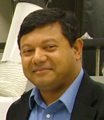


The two major experimental collaborations at Fermilab’s Tevatron, CDF and DZero, have joined forces to narrow the search for the Higgs boson. The as-yet undiscovered Higgs is the key to why particles have the masses they do, and is so significant to our understanding of nature that former Fermilab director Leon Lederman called it the "God particle." Based on results announced today by Fermilab, the mass/energy of the Higgs may lie in a region where, with experimental improvements, it could perhaps be identified at Fermilab before it is found at CERN’s Large Hadron Collider. Berkeley Lab physicists have long been important contributors to the international CDF collaboration. Wei-Ming Yao is involved in the direct search for the Higgs in the combined dataset from both experiments, and Berkeley Lab CDF group leader Lina Galtieri is helping to zero in on the Higgs mass through its relationship to the top quark. More>
 Scientists in the Lab’s Environmental Energy Technologies Division (EETD) played a role in developing the Google Earth map of North American fossil fuel carbon dioxide (CO2) emissions known as the Vulcan Project. The NASA and DOE-funded effort, based at Purdue University, quantifies CO2 emissions at space and time scales much finer than has been achieved in the past. EETD’s Marc Fischer, the project leader, Stephane de la Rue du Can, and former EETD staff Scott Murtishaw used data from the Environmental Protection Agency and the California Air Resources Board to develop emissions estimates. View a YouTube video here.
Scientists in the Lab’s Environmental Energy Technologies Division (EETD) played a role in developing the Google Earth map of North American fossil fuel carbon dioxide (CO2) emissions known as the Vulcan Project. The NASA and DOE-funded effort, based at Purdue University, quantifies CO2 emissions at space and time scales much finer than has been achieved in the past. EETD’s Marc Fischer, the project leader, Stephane de la Rue du Can, and former EETD staff Scott Murtishaw used data from the Environmental Protection Agency and the California Air Resources Board to develop emissions estimates. View a YouTube video here. ![]()
 Computing News: NERSC Newsletter Now Available
Computing News: NERSC Newsletter Now AvailableThe latest issue of the NERSC newsletter is now available. Beginning in March, NERSC news will be incorporated in a new monthly Berkeley Lab Computing Sciences Newsletter, which also includes information about the Computational Research Division and ESnet. To submit news items, and to subscribe, contact Linda Vu at [email protected] or x2402.
 In the News: Batteries That Charge in a Flash
In the News: Batteries That Charge in a Flash[Science Now] An improved cathode could lead to lithium batteries that fully charge in seconds and discharge equally rapidly — providing a quick power boost for electric cars. What's more, the advance relies on materials that are already commercialized. So the high-speed refinements could make it to market within a few years. "It's a very nice concept," says Berkeley Lab’s Marca Doeff. Full story.
 People: Majumdar Participates in UC Day
People: Majumdar Participates in UC DayArun Majumdar, Director of the Lab's Environmental Energy Technologies Division, participated Tuesday in the University of California's annual UC Day in Sacramento. UC Day is an opportunity for UC campuses and managed labs to educate state legislators, staff and policymakers about the impact the UC system has on jobs, energy, health care, innovation and the environment. This year, the highlight of the day was a panel discussion entitled “Today’s Ideas, Tomorrow’s Solutions." Majumdar participated in this discussion and focused on green energy and the potential for jobs and environmental progress. He was joined by other UC professors and researchers who covered issues ranging from the state's water crises to the potential impact of the federal stimulus funding package. The panel was moderator by UC President Mark Yudof. Held in the Governor's Conference Room, over 80 individuals attended including key legislative staff, members of the Administration and representatives from various state agencies.
Today at Berkeley Lab is produced by Public Affairs' Communications Department